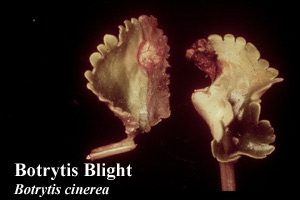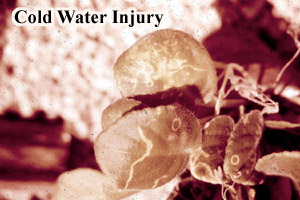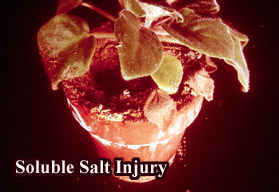African Violet (Saintpaulia)
Plant Health Problems
Diseases caused by Fungi:
Root and crown rot, Rhizoctonia solani and Pythium spp.
Symptoms appear as wilting and general droopiness of the foliage and are nonspecific. This flaccid appearance is often accompanied by browning and rotting of the roots and the crown. Yellowing and death of the outer leaves follows, until finally the entire plant is dead.
Control can be achieved by using a sterile potting mix and clean pots. It is also helpful to avoid overwatering, especially in the crown area of the plant. It is important to never let the plant sit in standing water. Highly symptomatic plants can be rogued and removed since recovery is unlikely.
 Botrytis blight or Gray mold, Botrytis cinerea.
Botrytis blight or Gray mold, Botrytis cinerea.
Infected flowers develop tan, papery patches and are often covered with gray, fuzzy masses. Senescing flowers are particularly susceptible. Tan to brown spots with a target-like appearance can also develop on the leaves. These patches are often associated with flowers which have dropped onto the leaf surface.
Good sanitation practices including grooming the plants and removing spent or senescing flowers can minimize the potential for infection. These affected tissues should be carefully removed and discarded when they are dry. It is also important to avoid wetting the flowers when watering and crowding plants. Adequate spacing between the plants can promote good air circulation. Control can also be achieved with the use of fungicide sprays applied as soon as symptoms are visible. Among the compounds registered for use in Connecticut are copper sulphate pentahydrate, mancozeb, and thiophanate-methyl. Consult the label for dosage rates, safety precautions, and indoor use.
Powdery mildew, Oidium spp.
White powdery spots or patches develop on the leaves. Symptoms often first appear on the upper surfaces of the leaves. White powdery patches can also develop on emerging blossoms.
Disease can be minimized by carefully picking off affected leaves as soon as symptoms are evident. Symptomatic leaves can be placed into a plastic bag in order to avoid spreading the spores of the fungus. Control can also be achieved with the use of fungicide sprays applied as soon as symptoms are visible. Among the compounds registered for use in Connecticut are copper sulphate pentahydrate, potassium bicarbonate, thiophanate-methyl, and sulfur. Consult the label for dosage rates, safety precautions, and indoor use.
Diseases caused by Nematodes:
Foliar nematodes, Aphelenchoides fragariae.
Light blotches or brown patches appear on leaves. These areas can enlarge and eventually involve the entire leaf and plant.
Picking and destroying affected leaves and avoiding splashing water from leaf to leaf or from soil to leaf can help to control these nematodes. Additionally, since these nematodes can exist for a short time as saprophytes in the soil or potting mix, repotting into fresh mix at the time of picking off the leaves can be very effective for control.
Diseases caused by Physiological/Environmental Factors:
 Cold water injury, cold water used for watering.
Cold water injury, cold water used for watering.
Irregular or ring-like pale tan spots appear on the upper side of the leaves. These may vary greatly in size and severity since some cultivars are more sensitive than others. Injury occurs when water which is colder than the surface of the leaf is used for watering. Symptoms are often more pronounced during the winter months.
This problem can be avoided by watering with tepid or room temperature water and by trying not to wet the foliage during watering.
 Soluble salt injury, excessive fertilization and accumulation of high levels of soluble salts in potting medium. Root injury caused by excessive levels of fertilizer in the potting mix results in a general decline or collapse of the plant. Symptoms are similar to those caused by root rot so soil analyses for soluble salt levels are often necessary for correct diagnosis. An indication of high soluble salts is the presence of white, crystalline deposits on the rim or outer surface of the pot or on the surface of the potting mix.Soluble salts can sometimes be leached from the potting mix by running a stream of water through the pot for approximately 20 minutes. However, when salt levels are excessive, the plant can be repotted into fresh, sterile potting mix and a clean pot. It is also important to avoid excessive use of fertilizer, especially during periods of slow growth.
Soluble salt injury, excessive fertilization and accumulation of high levels of soluble salts in potting medium. Root injury caused by excessive levels of fertilizer in the potting mix results in a general decline or collapse of the plant. Symptoms are similar to those caused by root rot so soil analyses for soluble salt levels are often necessary for correct diagnosis. An indication of high soluble salts is the presence of white, crystalline deposits on the rim or outer surface of the pot or on the surface of the potting mix.Soluble salts can sometimes be leached from the potting mix by running a stream of water through the pot for approximately 20 minutes. However, when salt levels are excessive, the plant can be repotted into fresh, sterile potting mix and a clean pot. It is also important to avoid excessive use of fertilizer, especially during periods of slow growth.
Insect Problems
Cyclamen mite, Phytonemus pallidus.
This translucent, microscopic mite often infests the new leaf and blossom buds, and can proliferate on spent blossoms. Characteristic injury includes dwarfed, thickened and wrinkled leaves. On azalea, dahlia, and other plants with stems, the distance between internodes becomes drastically shortened. Infested plants do not bloom, or blossoms may be misshapen. Cyclamen mite is not easily controlled when mature plants are badly infested: effective miticides are not available to homeowners, so a commercial applicator may be required for effective miticide applications. Restricted use materials effective against this pest include abamectin, dicofol, and endosulfan. Abamectin requires more than one spray to be effective. Consult the label for dosage rates and safety precautions.
Dwarfing:
Dwarfing and stunting of the new leaves, which are often distorted and hairier than normal, indicates infestation by cyclamen mites. See cyclamen mite.
Mealybugs, Planococcus citri.
White cottony masses appear on leaf surfaces, in leaf axils and sheaths. These insects damage plants by sucking plant sap. Among the compounds registered for control of this pest in Connecticut are insecticidal soap, ultrafine horticultural oil or resmethrin. Because of overlapping life stages in a home environment, multiple applications will be needed to control this pest. Spray needs to contact the insect. Microencapsulated diazinon is an effective restricted use insecticide. Consult the label for dosage rates and safety precautions.
Thrips, Frankliniella spp.
These small straw-colored insects feed on pollen and flower petals. Adult thrips have wings almost as long as their body. The four wings are veinless with long hairs on the leading and trailing edge. They quickly scurry into hiding when the plant is touched or they sense changes in the environment, so they are readily detected by exhaling on a blossom held over your hand, or tapping the blossom onto a white sheet of paper. The carbon dioxide in the breath will cause the thrips to exit the bloom and fall into your hand. Another sign of their presence is pollen spread downward from the anthers, spoiling the blooms. This is more noticeable on the darker-colored flower forms. The piercing and rasping caused by feeding thrips damages plants. Thrips also are important vectors for tomato ringspot virus. Effective insecticides include azadirachtin, fenoxycarb and spinosad. Consult the label for dosage rates and safety precautions.
Control in the home begins with buying clean plants and if needed, handpicking of infested blossoms. Control of thrips is especially important because they can vector tomato spotted wilt virus.

